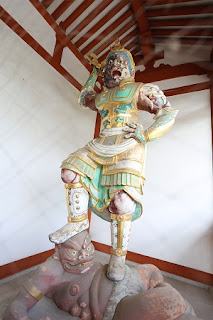World Heritage watching ; Yakushiji Temple
Yakushiji Temple
薬師寺
Originally founded in 680, this temple prospered under the patronage of the imperial court in the 8th century.
Since that time, the temple was to tragically lose all of its buildings to fire, with the exception of its east pagoda.
Restoration work has continued since 1967, and today, visitors can see many buildings reconstructed by using traditional methods and techniques.
奈良の薬師寺は「法相宗[ほっそうしゅう]」の大本山です。天武天皇により発願(680)、持統天皇によって本尊開眼(697)、更に文武天皇の御代に至り、飛鳥の地において堂宇の完成を見ました。その後、平城遷都(710)に伴い現在地に移されたものです。(718)
現在は平成10年よりユネスコ世界遺産に登録されています。
These pictures were taken on July 2015.
Yakushiji Temple
About Yakushiji Temple
Google map
Yakushiji Temple was built in the year 680 by the Emperor Tenmu, praying for a cure to the illness of Uno-no-Sararahime-Miko (Empress under Emperor Tenmu, and later the Empress Jito). The temple was originally located in Fujiwara-kyo (the capital city from 694 to 710). In 718, it was moved to its present location in the capital at Nara. Due to numerous fires, including the flames of war, the only building that remains of the temple of that period is the To-to (the eastern pagoda, of the two pagodas situated on the east and west). This pagoda is designated as a National Treasure. The Kon-do (the hall that enshrines the main deity) was restored in 1976. The Sai-to (the western pagoda) was restored in 1981, with the Chu-mon (the gate situated between Nandai-mon and the main buildings) being restored in 1984, and a portion of the corridor being restored in 1991.The To-to pagoda, which has three roofs, is a three-storied pagoda. This pagoda is especially noteworthy for the small roof-like eaves on each story, which make it look like a six-storied pagoda. The Yakushi-sanzon, which is housed in the Kon-do, is a leading Buddhist image of the 7th century. It was greatly admired by Ernest Fenollosa, an American who contributed to the restoration of traditional Japanese fine art in the 19th century.
Bell
鐘楼
Daikodo; lecture hall
大講堂
This hall is not only the largest hall in the temple, that is 41m. wide, 20m. deep, and 17m. high but also in the wooden architecture in this century in Japan. This hall enshrines Maitreya Buddha Triad, ( National important art object, Hakuho Period) who was introduced as a reincarnation of the real person of Buddha.
Maitreya Buddha Triad
弥勒三尊像 【重要文化財】 白鳳~天平時代
Kon-do; Main Hall (M)
Sai-to; West Pagoda (Rt)
To-to; East Pagoda (Lt) is under restoration work.
東塔(左) 金堂(中) 西塔(右)
There are some statues in the Main Hall.
Yakushi-sanzon; Yakushi-Triad in the Kondo
薬師三尊像(国宝・白鳳時代)
Sai-to; West Pagoda
西塔
There are statues of Buddha in the Pagoda.
Chu-mon; Middle Gate
中門
Nitennouzou ; Two Heavenly Kings
二天王像
Nan-mon; South Gate
南門
Genjo-sanzoin-Garan
玄奘三蔵院伽藍
Because of stricter food safety law by Japanese government, we have no worry about foods.
Warabi-mochi ; bracken-starch dumpling
わらび餅
Ekiben ; A box lunch sold at a railroad station
駅弁
Tempura ; deep-fried fish and vegetables in a light batter
天ぷら
4 years have passed since Fukushima Daiichi nuclear power plant accident. I have visited various places of Japan to see the health consequence of the accident.
Fortunately I have never found any impacts by the accident among Japanese creatures. As far as I know, nobody has health problem which is caused by the accident in Japan.
Our Prime Minister Abe assures that "The situation is under control. The influence of the contaminated water is completely blocked within Fukushima. There are no health-related problems until now and there will never be health problems." He also said that "Tokyo is 250 kilometers away from Fukushima, and the kind of danger that you imagine does not exist in Tokyo. Tokyo is a very safe city."
As PM Abe said, Nara Prefecture is very far away from Fukushima, people in there have no concern about the nuclear power plant accident. People in there have already forgotten the accident, because they think radioactive materials cannot reach there.
We know there is no problem for childbirth and child rearing in Nara Prefecture. So people in there have no concern about the accident.
I continue to visit various places in Japan to see the effects of the accident, because I can meet various creatures which are more sensitive to radioactive materials from the environment. It is important to see their health for our safety.
公衆衛生ネットワーク
Public Health Network in Japan


















0 件のコメント:
コメントを投稿